'Afflicted'
AS Production Group 12
Tuesday, 10 May 2011
Group Navigation of Evaluation, Final opening and Preliminary task.
Becki Ashby
-Evaluation 1
-Evaluation 2
-Evaluation 3
-Evaluation 6
Abbi Potter
-Evaluation 1
-Evaluation 2
-Evaluation 3
-Evaluation 6
Group
-Initial Audience research
-Target Audience
-Audience research
-Evaluation 7
-Overall evaluation, other half of Evaluation 7
Final Opening
-Our final opening and evaluation.
Preliminary task
-Our preliminary task and evaluation
Storyboard
-Our storyboard
Monday, 9 May 2011
Group - Final Piece + Overall Evaluation
Our brief for the final task was to create a 2 minute film opening that was typical to that of a genre that we could choose between a choice of thriller, horror and teen drama. Our chosen genre was a psychological thriller.
- When in the beginning stages of this project we had to firstly research ALL of the genres that we had an option in using to get an idea of the typical conventions for those genres and how a film opening might look.
- After having completed this thorough background research we decided to choose our main genre as a thriller.
- At this point we already had a few ideas of what our plot might be and what kind of shots and compositions we might wish to use. Watching The Bourne Supremacy opening and the Seven opening we gained inspiration for doing a postmodern and almost a hallucinogenic style of opening.
- Once having decided on our storyline we then had to consider what locations we would want to use for our opening to fully communicate our genre. Therefore, we had to go on location recces to places such as High Brooms station (where our murder scene is shot).
- Interesting shot sizes and the framing of those shots e.g.
- The use of blank black shots to help create tension.
- The layering of different tracks of music
- The effects that we used e.g.
- The titles e.g.

- Some of the sound doesn't anchor the narrative as well as it could
- The cutting rate could also do with improvement to help to create a bigger build up of tension
Group - Evaluation 7 - Preliminary Task: What We've Learnt.
The brief for our preliminary task was...
-The use of continuity editing needed to be incorporated into out footage, this means the illusion of a continuous line of action.
-The use of a short conversation was part of the brief, for this we chose to have two separate sets of dialogue as a conversation did not fit the conventions of our style of opening.
-Opening a door was another part of our brief, this was an example of continuity editing used in our task. Here is an example of this from our task...
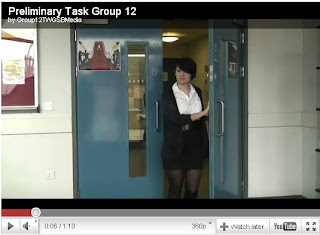
-Experimenting with different camera angles and techniques was also part of our brief, this includes shots such as CU, LS, MS, Canted angles, Tracking shots and effects used within editing. Here is an example of this...
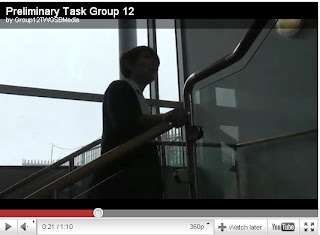
Choosing the genre, costume and props were key parts in producing a creative response to the brief. The genre we chose was psychological thriller which matched the genre we were planning to do for our opening. There were some limitations of this...
-As we were in school we did not have the access to any other locations other than on the school grounds, we tried to overcome this by using places which look as if they are not in a school such as the road and zebra crossing outside the school.
-The costume was also restricted by the fact we were in school as we were in our school uniform thus could not show character exposition through costume.
-We faced the same problems with props which is why we decided to use effect's when editing our task in order to make a creative response. Here is an example of this...
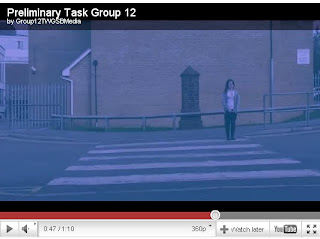 The planning we used for our preliminary task was...
The planning we used for our preliminary task was...-Looking over previous filming experiences such as the Wilderness wood reccie and identifying shots and specific features which we thought worked well and planned to use in our preliminary task.
-Thinking about the narrative of our preliminary task, for example writing a script, although there is not a lot of dialogue in ours.
-Finding a location to film our task, we chose to use the road outside the school as well as the stairs and corridor. Here is an example of this

-We then done some practice shots around the school so that we were fully prepared for when we actually filmed our task, from this we could identify what worked well and what we were going to re create in our real thing.
-Another problem was the costume, again as we were in a school environment we were restricted as to what we could use, in order to overcome this we ensured that costume would not be a big part of our narrative therefore making it irrelevant.
-Another problem we faced was the continuity editing of our piece, neither of us had previous experience in editing therefore found this hard, in order to overcome this we ensured that we left our selves enough time to edit ensuring that we could overcome any problems we faced.
-Strengths: I think that the effects used in our preliminary task such as the colours flashing worked really well and gave us inspiration for our final piece. This helped to create the sense of confusion that we were aiming for. The music also worked well in order to create this effect.
-Weaknesses: I think that the main weakness of our piece is the continuity editing although this could be easily worked on it does let the task down as a whole.
Our preliminary task...
Tuesday, 3 May 2011
Group- Results from audience research- screening.
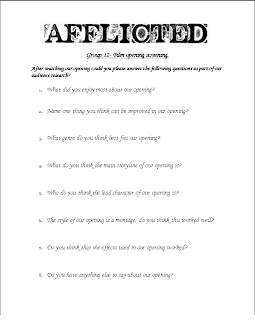
Results from questionnaire
AP Evaluation 6 - Media Technologies
- Because this task was a group task we needed to work somewhere where it was easy for us to work collaboratively and to have all our research and ideas in one place. By using http://www.blogger.com/ and 'blogging' we successfully managed to do so. Moreover by having a definitive place to record our progress etc we were able to focus on individual points and be more selective with our research because we could assign each other particular tasks.
 To actually film our opening sequence we used a 1080p High Definition Camcorder and a tripod. The high definition gives a clearer and more crisp picture and the tripod helps to keep the camera still in order to avoid shaky camera movement that spoils the atmosphere or tension that you try to create with smooth filming. However, shaky camera movement is necessary at times when trying to make the audience feel involved.
To actually film our opening sequence we used a 1080p High Definition Camcorder and a tripod. The high definition gives a clearer and more crisp picture and the tripod helps to keep the camera still in order to avoid shaky camera movement that spoils the atmosphere or tension that you try to create with smooth filming. However, shaky camera movement is necessary at times when trying to make the audience feel involved.
- Where lighting is concerned, we were very fortunate in that when we did the bulk of our filming the weather was exactly how we wanted it and therefore helped with the composition of our shots. For example, when we were out shooting in the park the sun was shining and so we placed the camera in different angles so that we could achieve different effects and see different shadows.
- We faced very little problems on our actual shoots, the weather was always how we needed it to be. However, some of our CUs of natural objects were unsteady and shaky because a tripod was not used. To creatively overcome this, we used our technique of montage editing so we incorporated our shaky shots to create disorientation.
- At first we spent a lot of time experimenting with different effects and colours to fully emphasise the fact that our montage was a dream, for example, using these effects for surrealism. When we had finished our 'experimenting' we ended up with a sequence that was more ambiguous than we wanted and too much was happening that you couldn't understand the plot of the opening.
- Furthermore, we decided to use a smaller range of effects to give a sense of continuity and flow to a piece that was not supposed to be continuous. This eventually worked really well and was easier to understand but at the same time also kept you active and open to different possibilities.
- To edit all of our footage and to finally create our opening sequence we had to use an editing software called Adobe Premiere Elements, upload our footage to the software and on to a timeline.
- Once we had all our footage uploaded and placed onto the timeline in a rough idea of where we wanted it we started to cut the footage down to our requirements. This proved to be a challenge. After having an overall 30minutes of footage we managed to cut it all down to 50 seconds. This was obviously not a great start.
- However, we managed to prioritise different shots and slightly change our timeline so that we met the required 2 minutes of film. From this we have now learnt to do as much filming as you can even if you don't think you need to, we also learnt that planning and storyboarding is extremely important.
- Compared to real film production, our opening is different because we didn't actually need to make a whole film and so we didn't need to get bankable stars and think too seriously about finance and the final quality of our piece. We also didn't have the advanced equipment that professional filmmakers would have or the expert skills in editing. However, overall I am very pleased with our outcome and with our editing.
- In addition to this there was also the issue of the timescale we were given, which would be quite difficult to compare to a real film production.
AP Evaluation 3 - Media Institutions
 Distribution companies that I have researched include Fox Searchlight Pictures, Paramount Classics, Miramax and Optimum Releasing. For our particular film i would hope to use Optimum Releasing as it is a British based distribution company that focuses on independent films. They are one of the most prominent distributors in the UK concerning independent cinema.
Distribution companies that I have researched include Fox Searchlight Pictures, Paramount Classics, Miramax and Optimum Releasing. For our particular film i would hope to use Optimum Releasing as it is a British based distribution company that focuses on independent films. They are one of the most prominent distributors in the UK concerning independent cinema.Wednesday, 27 April 2011
Group - Target Audience
- Over the age of 15
- Male and female
- Working class
- Enjoys films of the thriller genre.
 Prefers Arthouse films but is happy to engage in mainstream cinema
Prefers Arthouse films but is happy to engage in mainstream cinema
- What did you enjoy most about our opening?
- Name one thing you think can be improved in our opening?
- What genre do you think best fits our opening?
- What do you think the main storyline of our opening is?
- Who do you think the lead character of our opening is?
- The style of our opening is a montage, do you think this worked well?
- Do you have anything else to say about our opening?
Tuesday, 26 April 2011
AP Evaluation 2 - Social Groups
- In our opening sequence the social group represented is young white middle class females, other persons of ethnic origins, men and people of working or upper class backgrounds are not included in our opening.
- The young, white, middle class females in our opening are represented both positively and negatively. One being a murderer (antagonist) and the other being an innocent victim (protagonist). Through both characters we challenge social norms and show the traditional stereotypical view of women.
- The antagonist is female and therefore challenges gender stereotypes because usually a male would be a murderer. However, the protagonist is also female, she is wearing stereotypically feminine clothing which is coloured appropriately purple unlike the antagonist who is dressed in dark jeans and a black, unflattering jumper - not following the codes of femininity.
AP Evaluation 1 - Media Conventions
In what way does your media product use, develop or challenge forms and conventions of real media products?
Genre, form and style of our opening
In my opinion, our opening sequence is conventional to the genre of psycho-thrillers. This is because compared with some of the opening sequences we researched e.g. The Bourne Supremacy, Seven etc (of which we took a lot of inspiration from Bourne) a common style of opening is a montage.
Similarly to the opening of The Bourne Supremacy our opening was that of a dream. The position of our titles within the sequence, I believe to be typical of a thriller as we used them to build tension. Not necessarily were they conventional to a psycho-thriller but the font ‘Mom’s Typewriter’ gave a sense of something unnatural and linked to the shots of book pages in our opening.
How does your piece conform or challenge the conventions of your chosen genre?
Characters
Our opening sequence both conforms to AND challenges typical gender stereotypes in psycho-thrillers. The main character goes against the conventional main character of a thriller because she is female however she is still shown as a vulnerable character which is a common stereotype for women. Similarly our stock character is female which conforms to the conventions of a thriller.
Plot
The plot of our opening, a murder, is conventional of a thriller. This murder is that of a stabbing which is also considered as a typical convention of our genre because it gives a sense of a more urban environment and uses the common iconography of a knife.
This murder also takes places within a dream which is more typical of our psychological sub-genre and is communicated through our use of a montage.
Sound
In our opening we have various layers of different sounds to create a sense of disorienation. We used sounds from http://www.freesound.com/ which was really useful for finding interesting sounds such as:
- A music box
- A distorted guitar
- Birdsong
These are not typically conventional to a thriller as they do not create tension but the way in which we edited the sound i.e. having bits fade in and out and overlay eachother, helped to build the atmosphere that we wanted.
Camera Work + Framing
For the majority of our opening sequence we used midshots, MCUs and CUs. We used these shot sizes because we needed to show the details of objects and faces to emphasise the disorientation and confusion of a dream and create an enigma. In addition to this we used several shots with a canted angle to support this.
Sunday, 10 April 2011
B- Technologies and the process of making the film opening.
-The main use of technology within the project was our blog, the blog site we used was blogger which allowed us to work collaboratively as we could both contribute and discuss ideas at any time. This also helped us work better as a group when conducting group work and allowed us to focus on certain points. Here is an example of how we worked collaboratively on the blog...
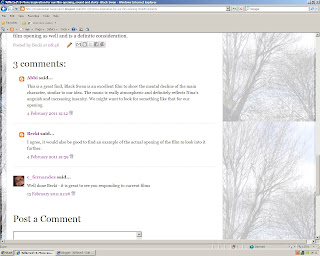
-Other uses of technology were slideboom in order to upload our powerpoint presentations onto Blogger as well as Prezi in order to make presentations and survey monkey to create an online survey which we used for our target audience research before the 'pitch' Here is the website slideboom...
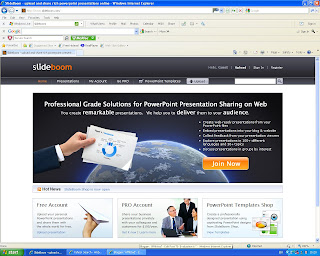
-After discussing ideas on the blog in particular researching locations and planning which scenes and shots we would be filming, we then created risk assessment forms for each location we would use to minimize risks of our filming.
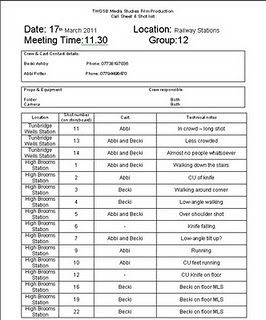
-To film our opening we used a 1080p HD digital camcorder as well as a tripod so we could create smooth and steady camera movements for example, tracking shots when walking in the station shoot. Although, we did use handi cam to shoot some shots as we felt that they suited our style better.
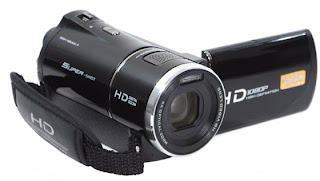
-Some problems we faced when shooting were in that in some of the nature shots the camera was unsteady as a tripod was not used, this did not work in our piece so we had to re shoot some of the shots as well as cutting others so that the disjointment was not noticeable.

-For the lighting aspects of our piece the weather conditions at the time of our shoot worked really well for example in the park shots it was a sunny day therefore there was bright lighting which reflected on the happy mood we were trying to set. This contrasts to the dull lighting in the underground tunnel at High brooms station which also reflects the mood we were trying to achieve and helped to set the scene. For the bath shot we lit candles to create an atmospheric feel which anchored the footage.
-Special effects were a big part of our effects as our montage consists of a dream containing lots of illusions, focusing on certain parts of the shot as well as blurring and colour washes were main parts of our effects. Other effects such as cartoon/ black and white prints were effects used in our piece these worked particularly well in making it seem surreal and giving it a dream like feel. One problem which we encountered whilst adding effects to our footage was the lack of continuity, firstly we used a whole load of different effects which didn’t work. To solve this were started using a smaller variety of effects, this worked well in making our piece flow. Here is an example of one of the effects used in our opening...

-After all our footage was shot we had to edit it, to do this we uploaded it all on to the computer and then transferred it to the editing software, Premier. We then dragged all our footage onto the timeline. Here is the software we used...
• After this the first thing we done were placed the footage in a rough order of how we were expecting our final piece to look. We also began cutting the shots and removing/ choosing which take of a certain shot worked best. Here is a screen shot of our timeline... 
-When we were left with only the footage we needed we began working through starting at the beginning and adding our special effects to each shot, this included filters, blurs, and changes in time, reverses and standard effects.
An example of this is the black and white over the murder shot...  -We then began to work out the cutting rate of our piece and added in the blank gaps we used in order to create the effect of disjointment and follow the idea of it being a dream.
-We then began to work out the cutting rate of our piece and added in the blank gaps we used in order to create the effect of disjointment and follow the idea of it being a dream.
-We then looked at the brightness, contrast and saturation of our shots and ensured they followed the conventions of the genre and worked well within our concept.
-We then added transitions such as fading and dissolves so that our footage flowed and to reinforce the idea of it being a dream.
-Next we added the text screens/ titles using the font ‘moms typewriter’ as well as this we placed them into their places on the timeline and ensured that the flowed with the rest of the footage. Here is an example of our fonts...  -Next we looked into sound and used a whole variety of sounds layered on top of each other to create the idea of confusion within the dream.
-Next we looked into sound and used a whole variety of sounds layered on top of each other to create the idea of confusion within the dream.
-We then did a final cut of all the footage to ensure that it cut at the right time so that the sound anchored the footage and we were happy with our final outcome.
-Next we exported our opening from premiere by clicking on the 'share' button, saving it on our personal computer and then uploading it on to YouTube so that it could be embed further to places such as the blog.
-In the process of making our film opening we both learnt a lot, in particular we both learnt how important storyboarding and planning is to ensure that you are able to get the most out of shoots. We also learnt that you should shoot more footage than needed so that you can ensure that you get the best shots as well as enough footage after editing. The rule of thirds is also key when filming as well as the 180 degree rule to ensure that the final outcome is good. Here is an example of a template used for our storyboarding...
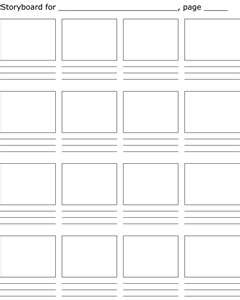
-Our production compared to real film production is different in the respect that we did not have access to the same sorts of actors, location or equipment although I do think that we managed to create a realistic film opening. Time was another issue which made it hard to com pares to real film production but again I think we managed well in the time we were given. Although it does not look as professional as most mainstream movies, we did manage to create a good opening which followed the conventions of the genre we chose, psychological thriller.
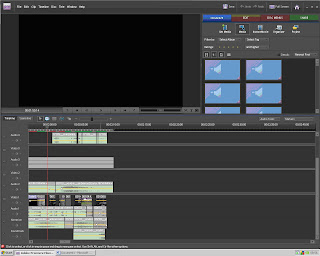
B- Evaluation 3- Media Institutions
After the advertising and distribution is sorted we would need to decide how much to invest on promotion and exhibition of the film, we could exhibit either nationally or worldwide and to both niche audiences such as a art house cinemas for example Trinity, Soho Curzon and Prince Charles cinema as well as mass markets such as odeon.

















